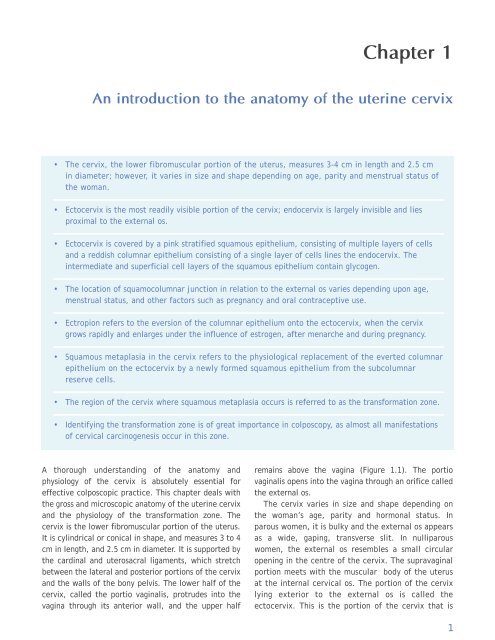Colposcopy and Treatment of Cervical Intraepithelial Neoplasia - RHO
Colposcopy and Treatment of Cervical Intraepithelial Neoplasia - RHO
Colposcopy and Treatment of Cervical Intraepithelial Neoplasia - RHO
Create successful ePaper yourself
Turn your PDF publications into a flip-book with our unique Google optimized e-Paper software.
Chapter 1<br />
An introduction to the anatomy <strong>of</strong> the uterine cervix<br />
• The cervix, the lower fibromuscular portion <strong>of</strong> the uterus, measures 3-4 cm in length <strong>and</strong> 2.5 cm<br />
in diameter; however, it varies in size <strong>and</strong> shape depending on age, parity <strong>and</strong> menstrual status <strong>of</strong><br />
the woman.<br />
• Ectocervix is the most readily visible portion <strong>of</strong> the cervix; endocervix is largely invisible <strong>and</strong> lies<br />
proximal to the external os.<br />
• Ectocervix is covered by a pink stratified squamous epithelium, consisting <strong>of</strong> multiple layers <strong>of</strong> cells<br />
<strong>and</strong> a reddish columnar epithelium consisting <strong>of</strong> a single layer <strong>of</strong> cells lines the endocervix. The<br />
intermediate <strong>and</strong> superficial cell layers <strong>of</strong> the squamous epithelium contain glycogen.<br />
• The location <strong>of</strong> squamocolumnar junction in relation to the external os varies depending upon age,<br />
menstrual status, <strong>and</strong> other factors such as pregnancy <strong>and</strong> oral contraceptive use.<br />
• Ectropion refers to the eversion <strong>of</strong> the columnar epithelium onto the ectocervix, when the cervix<br />
grows rapidly <strong>and</strong> enlarges under the influence <strong>of</strong> estrogen, after menarche <strong>and</strong> during pregnancy.<br />
• Squamous metaplasia in the cervix refers to the physiological replacement <strong>of</strong> the everted columnar<br />
epithelium on the ectocervix by a newly formed squamous epithelium from the subcolumnar<br />
reserve cells.<br />
• The region <strong>of</strong> the cervix where squamous metaplasia occurs is referred to as the transformation zone.<br />
• Identifying the transformation zone is <strong>of</strong> great importance in colposcopy, as almost all manifestations<br />
<strong>of</strong> cervical carcinogenesis occur in this zone.<br />
A thorough underst<strong>and</strong>ing <strong>of</strong> the anatomy <strong>and</strong><br />
physiology <strong>of</strong> the cervix is absolutely essential for<br />
effective colposcopic practice. This chapter deals with<br />
the gross <strong>and</strong> microscopic anatomy <strong>of</strong> the uterine cervix<br />
<strong>and</strong> the physiology <strong>of</strong> the transformation zone. The<br />
cervix is the lower fibromuscular portion <strong>of</strong> the uterus.<br />
It is cylindrical or conical in shape, <strong>and</strong> measures 3 to 4<br />
cm in length, <strong>and</strong> 2.5 cm in diameter. It is supported by<br />
the cardinal <strong>and</strong> uterosacral ligaments, which stretch<br />
between the lateral <strong>and</strong> posterior portions <strong>of</strong> the cervix<br />
<strong>and</strong> the walls <strong>of</strong> the bony pelvis. The lower half <strong>of</strong> the<br />
cervix, called the portio vaginalis, protrudes into the<br />
vagina through its anterior wall, <strong>and</strong> the upper half<br />
remains above the vagina (Figure 1.1). The portio<br />
vaginalis opens into the vagina through an orifice called<br />
the external os.<br />
The cervix varies in size <strong>and</strong> shape depending on<br />
the woman’s age, parity <strong>and</strong> hormonal status. In<br />
parous women, it is bulky <strong>and</strong> the external os appears<br />
as a wide, gaping, transverse slit. In nulliparous<br />
women, the external os resembles a small circular<br />
opening in the centre <strong>of</strong> the cervix. The supravaginal<br />
portion meets with the muscular body <strong>of</strong> the uterus<br />
at the internal cervical os. The portion <strong>of</strong> the cervix<br />
lying exterior to the external os is called the<br />
ectocervix. This is the portion <strong>of</strong> the cervix that is<br />
1
















